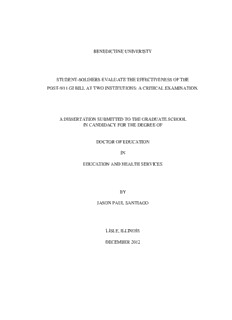
Running head: Strategic planning models PDF
Preview Running head: Strategic planning models
BENEDICTINE UNIVERISTY STUDENT-SOLDIERS EVALUATE THE EFFECTIVENESS OF THE POST-9/11 GI BILL AT TWO INSTITUTIONS: A CRITICAL EXAMINATION. A DISSERTATION SUBMITTED TO THE GRADUATE SCHOOL IN CANDIDACY FOR THE DEGREE OF DOCTOR OF EDUCATION IN EDUCATION AND HEALTH SERVICES BY JASON PAUL SANTIAGO LISLE, ILLINOIS DECEMBER 2012 Copyright by Jason Paul Santiago 2012 All rights reserved ACKNOWLEDGMENTS A special “thank you” is extended to the members of my dissertation committee who provided their dedication, guidance, and passion to help me realize a long awaited dream. In the words of Allan Ostar, Former President, AASCU, “Change is in the air. Things are happening in the political and social realms that are having a profound impact on both the military and education fronts.” With both humility and gratitude, I acknowledge the valuable advice and direction I received from Dr. Gary Davis, Dissertation Committee Chairman, former director of the Illinois Community College Trustees Association (ICCTA); Dr. Lynn A. Tovar, Dissertation Director, Associate Professor and Program Director at Lewis University, Illinois; Dr. Randy Plunkett, Technical Advisor, Retired SMSgt U. S. Air Force, and Director of Community and Government Outreach at Military.com; Dr. Stephen Nunes, Dissertation Reader, Academic Program Coordinator, First Responder’s Program, Professional Development, and Weekend College at Benedictine University, Illinois. Without all of you, this study could not have been completed. Thank you. Without the support of my family and close friends during this adventure, none of this would have been possible. Thank you for being there when I needed you – through the good days and the bad – always faithful! iii I pledge allegiance to the flag of the United States of America, and to the republic for which it stands, one nation under God, indivisible, with liberty and justice for all. iv DEDICATION To my father and mother who sacrificed their futures to invest in my education, and provided me the opportunity to excel and experience the American Dream. Thank you! To the brave veterans for protecting our great country and maintaining our freedom to conduct a quantitative methodology like these and share the results within the academic and military communities alike. v PSALM 23 (A psalm of David) Soldier’s Prayer The Lord is my shepherd, I shall not want. He makes me lie down in green pastures, He leads me beside quiet waters, He restores my soul. He guides me in paths of righteousness for His name’s sake. Even though I walk through the valley of the shadow of death, I will fear no evil, for You are with me; Your rod and Your staff, they comfort me. You prepare a table before me in the presence of my enemies. You anoint my head with oil; my cup overflows. Surely goodness and love will follow me all the days of my life, and I will dwell in the house of the Lord forever. Amen vi TABLE OF CONTENTS Page ACKNOWLEDGMENTS ................................................................................................ III DEDICATION ................................................................................................................... V PSALM 23 ........................................................................................................................ VI LIST OF APPENDICES .................................................................................................... X LIST OF TABLES ............................................................................................................ XI GLOSSARY .................................................................................................................... XII ABSTRACT ................................................................................................................... XIV CHAPTER 1 – INTRODUCTION ..................................................................................... 1 Statement of the Problem .................................................................................................... 5 Purpose of the Study ........................................................................................................... 6 Research Questions ............................................................................................................. 7 Research Hypotheses .......................................................................................................... 7 Limitations of the Study...................................................................................................... 8 Veterans Affected ......................................................................................................... 9 Significance of the Study .................................................................................................. 10 Differences Between a Community College and a For-Profit University ........................ 11 Definitions of Key Terms ................................................................................................. 14 CHAPTER 2 –REVIEW OF LITERATURE ................................................................... 16 Historical Perspective: Early Form of GI Benefits ........................................................... 16 The United States in the 1940s ................................................................................... 18 Value of Higher Education and the Impact on the Economy. .................................... 20 Servicemembers Opportunity College (SOC) ............................................................ 22 The Veterans Readjustment Act or the Korean GI Bill .............................................. 25 Veterans Readjustment Benefits Act or Vietnam Era Bill.......................................... 26 The Veterans’ Education and Employment Assistance Act ....................................... 27 New GI Bill / Montgomery GI Bill (MGIB) .............................................................. 28 Montgomery GI Bill‒Active Duty (MGIB-AD)......................................................... 31 Post-9/11 GI Bill ......................................................................................................... 32 Yellow Ribbon Program ............................................................................................. 34 Research Question One ..................................................................................................... 35 Characteristics of Veterans ......................................................................................... 36 Research Question Two .................................................................................................... 38 Challenges and Barriers of Higher Education ............................................................ 38 Schlossberg’s Transition Theory ................................................................................ 44 vii Moving In (Military) ............................................................................................. 48 Moving Through (Military) .................................................................................. 49 Moving Out (Military) .......................................................................................... 49 Mezirow’s Theory of Transformative Learning ......................................................... 52 Perspective Transformation: The Model. ............................................................. 56 Tinto’s Student Integration Model .............................................................................. 58 Adult Education Theories ........................................................................................... 60 Andragogy................................................................................................................... 64 When They Return Home ................................................................................................. 68 Difficulties Veterans Suffer ........................................................................................ 70 Traumatic Brain Injury ............................................................................................... 77 Research Question Three .................................................................................................. 79 Research Question Four .................................................................................................... 85 CHAPTER 3 – METHODOLOGY .................................................................................. 89 Rationale for the Quantitative Design............................................................................... 89 Research Design................................................................................................................ 90 Population and Sample ............................................................................................... 92 Data Collection Procedures ......................................................................................... 93 Demographic Attributes and Data Analysis ..................................................................... 99 Cross Tabulation ......................................................................................................... 99 Similarities Between Police Work and the Armed Forces.............................................. 100 Limitations ...................................................................................................................... 101 CHAPTER 4 – ANALYSIS AND RESULTS ............................................................... 103 Survey Procedures .......................................................................................................... 103 Summary of Findings ...................................................................................................... 115 Hypotheses and Research Questions .............................................................................. 115 Hypotheses ................................................................................................................ 115 Research Question One ............................................................................................. 116 Research Question Two ............................................................................................ 117 Research Question Three .......................................................................................... 118 Research Question Four ............................................................................................ 119 Hypothesis 1.............................................................................................................. 120 Hypothesis 2.............................................................................................................. 120 Hypothesis 3.............................................................................................................. 121 Conclusions ..................................................................................................................... 121 CHAPTER 5 – DISCUSSION ........................................................................................ 123 Summary ......................................................................................................................... 123 Discussion of the Findings .............................................................................................. 124 Research Question One ............................................................................................. 124 Research Question Two ............................................................................................ 125 viii Research Question Three .......................................................................................... 126 Research Question Four ............................................................................................ 127 Recommendations ........................................................................................................... 128 Personal Learning Experiences ....................................................................................... 129 APPENDICES ................................................................................................................ 132 REFERENCES ............................................................................................................... 153 ix LIST OF APPENDICES Page Appendix A. Veterans’ Educational Benefits Categories .............................................. 133 Appendix B. IRB Forms ................................................................................................ 135 Appendix C. Survey Questions ...................................................................................... 141 Appendix D. Permission to Use Copyrighted Material ................................................. 150 x
Description: